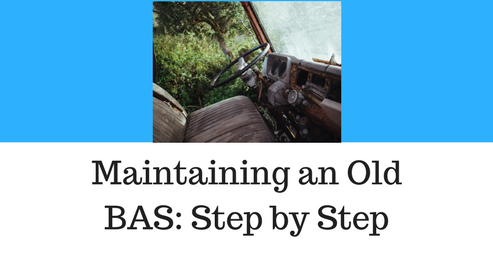They both stink, grow old and fall apart.
I had the wonderful pleasure of taking about 30 bags of decaying yard waste to the dump. I would say you haven't lived until you've smelled the sweet aura of decaying grass, but that would be a complete lie.
How did things get so bad? When I thought about it I realized I only produce 6 bags of grass per mowing, that means that I went 5 weeks without taking this grass to the compost dump.
I'd like to say that, in my defense, I didn't know that there was a compost dump a mere 6 minutes from my house...
And so by now, you're wondering what does this have to do with building automation?
It has everything to do with building automation.
There has been this myth that a building automation system can run forever, that you never need to upgrade or maintain it. After all, it's not like field controllers have fan belts that wear out.
And so, across the globe, millions of building automation systems sit in disrepair, held together by duct tape and hope... mainly hope.
So how do you undo years of neglect, especially if you have no budget?
That, my friends, is the purpose of this article. By the time you finish it, you will have a step-by-step plan to maintain your BAS (for a time).
The plan
I get, it you don't have a budget and, even if you did have a budget, you wouldn't spend it on your BAS. I'm not going to lecture you on how dumb it is to not maintain a BAS - you are where you are and it's time to fix it.
First things first, let's figure out what you have. Do you know what task I spent the most time on back when I was in service?
Figuring out what people had in their buildings.
Identify what you have
You'd be shocked, well maybe, by how many building owners have no idea what is in their buildings. And even the building owners who do try to keep track of what they have are often held hostage by shoddy as-builts and semi-accurate controls drawings.
Thus the first thing you need to do is to inventory your systems, make sure your controls drawings are correct, and if not fix the documentation.
Cost: Just Time
Make sure what you have works
I know this seems very obvious but ask any person who has been in the world of BAS for more than a few years and they can tell you horror stories about sites that had controllers offline for YEARS! One of the fundamental requirements for your BAS to work is that it must be online and running. So in this step we are going to make sure everything is working. How do we do this?
- Run an offline report and check for any controllers or points that are offline
- Run a report or visually check the user interface for any points that defy logic (Space temperatures that are negative 32 degrees F in the middle of summer...)
- Once you have all of these issues identified then you need to begin the troubleshooting process. Here is an article I wrote about troubleshooting communication trunks and offline controllers.
Cost: Time and potentially some new controllers/wires
Move your BAS Server
Do you have your BAS server under your desk, or in a closet, or on a shelf? It's ok if you do...
We're going to change that. The BAS server is quite possibly the most important piece of your building automation system.
The server acts as your graphical user interface, scheduling tool, and much more.
We need to move it somewhere safe. Like the IT closet.
Now, I can't tell you the process for doing that at your business I can just tell you this. Your BAS server should meet these criteria.
- Your server should be sitting in a dedicated, secured, conditioned area.
- Your server should if possible be hooked up to both a UPS (Uninterrupted Power Supply) and emergency power.
- If you are running really old software Windows 95, 98 etc, try to get the server imaged and put on a Virtual machine. There's nothing worse then your BAS dying and you not being able to get it running again.
Cost: Time and potential internal IT costs
If Possible Backup Your Data
What happens if a controller fails, do you have a backup of your programs? Do you have a backup of your graphics and databases?
For most folks, the answer to that is no.
But it doesn't have to be. there is quite possibly no other action with as high a return on investment as backing up your data. Yet folks don't do it...
Here's what you need to do.
Either you or your controls contractor needs to backup your supervisory device and all field controllers.
Store these files on both a local disk and on a cloud storage site like Dropbox or Google Drive.
And you're done...
It's that easy, just do it.
Cost: Time and potential contractor costs
Identify points of failure, and prepare
If your BAS server goes down how do you access your graphics?
If your plant controller goes down, do you have a spare?
What if the controller is 20 years old, can you even buy a spare?
Many people live one failure away from disaster. You can choose to ignore this or you can put a plan in place. Here is what I recommend.
Identify system failures that will take down your BAS and put a plan in place:
- Purchase spare controllers
- Make copies of your BAS server and virtualize it
- Have an upgrade plan in place if you can no longer purchase your BAS devices
Cost: Time, material, and potential contractor costs
Conclusion
So there you have it, you now have 5 steps you can take to maintain the life of your existing building automation system. Now don't get me wrong.
I strongly advocate you upgrading your BAS to the latest software at least every year and hardware at least every 5 to 10 years. At the same time, I realize a lot of folks do not have any room in their budget to do this.
So to be clear, these actions will help you survive another battle but they are a field bandage at best if your system is quite old it's really worth looking at upgrading.
Here are my questions for you.
What do you do to maintain a BAS?
How do you decide when to upgrade your BAS?
Post your answer in the comments section below!






